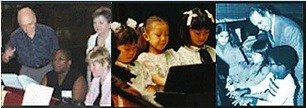
By Dr. Robert Pace
All of us have seen the frustrating situation in which a student struggles, with sixth level repertoire with a second level reading ability. The continued development of musical reading skills should always be of high priority.
First of all, let's explore the old myth that "sightreading" only takes place the first time around. The Europeans have long made a distinction between "Prima Vista Spiel" (the first time one reads) and "Sightreading” in general which simply indicates one is reading from a musical score whether the second or tenth time. Obviously, "Prima Vista Spiel" is important since it is the first contact with a new composition. How can one get a satisfying or accurate impression of the new piece if the performance is full of rhythmic, melodic and harmonic inaccuracies? For the poor reader, this "Prima Vista Spiel" must be extremely frustrating if not downright self-defeating. A great deal of apprehension obviously builds up within the student as he realizes that he is about to launch on another long and arduous series of "trial and error" practice sessions in an attempt to beat another piece of music into submission.
On the other hand, the student who gets the real sound of the music on first reading realizes that it is well within his capabilities. After this first successful reading experience he then goes back over the material to do more detailed reading or to memorize the piece if he so desires. But memory is actually an extension of this first experience. The good "first sightreader" has somehow learned to coordinate his eyes, ears, and fingers as he recalls in split second sequences certain previously experienced concepts or patterns. And, as he "thinks in motion," he translates these into meaningful musical ideas for that fleeting instant. It should emphasized that reading only unfamiliar material is actually not desirable. Music with some prior acquaintance frequently holds a higher interest level, hence may stimulate the student to concentrate more than if it were totally new. But these familiar pieces should not simply be "played by ear." The student must bring all his reading prowess to bear on them in the same manner in which he deals with the unfamiliar patterns of a totally new composition. First and foremost, whether he is reading a familiar or unfamiliar piece of music, he must think!
In dealing with remedial students, I will often pick familiar repertoire deliberately so that we can build on something they seem to recogize. From these pieces they can learn to recognize melodic patterns, deal with rhythm and "X-ray" the chord progressions.
Here are a few of the procedures I find helpful for both the continued growth of good readers and for the correction of reading deficiencies with remedial students:
1. Before we sightread the composition we look at the title. it may give us a clue regarding the overall interpretation. There is a lot of difference between a Waltz and a Funeral March!
2. Immediately identify the clefs, key signature, key or mode and meter at the beginning of the piece. Look through for any alteration of these elements.
3. Scan the entire piece to identify the larger sections.
4. Make a mental note of all similarities, such as repetitions, sequences. recurring rhythmic and harmonic patterns, etc. When we locate similarities, most often we pinpoint the differences as well, but not vice versa.
5. Learn to simplify and consolidate musical material. For example, the second phrase may be a repetition of the first except that the composer has substituted an Alberti bass for block chord accompaniment.
6. Locate any potential problem areas. Think through how you may best deal with them.
7. Before playing the piece, we must establish a tempo which can be managed throughout. The tempo must not be so fast that it will cause stumbling, yet it must be fast enough for us to feel the beat and rhythm, and to get the feel of the phrase line. If the tempo is too "slow-motion" we will not get an accurate impression of the music.
8. Once we begin, we must keep going at all costsl Even if we miss a note, a chord, or a rhythm, we must keep the beat going and move steadily ahead. We can go back later and figure out what happened where the stutter occurred. Too many of us unwittingly perfect the art of stuttering and stopping, rather than the art of continuity, keeping the music going.
9. Analyze your problem spots after you have played them. Why did you encounter trouble? Now try it again with your mind in high gear as you think aheads to solve this problem. You are leaming to cope with musical notation so that you can read instead of stumble through the score.
10. Finally, organize your strategies for either memorizing this piece, tor further sightreading, or for simply putting it aside so that you can go on to other pieces. Much of this article has, dealt with the two words, "keep going." Suppose a student has already acquired the bad habit of stopping and fumbling. A good remedy for this is ensemble sightreading practice not less than three times a week. If this cannot be done with the students at home on their own, a practice assistant or cadet teacher should be assigned. Stress with the student the importance of always playing in a musical way, observing proper dynamics phrasing and the many subtleties which occur in any piece of music. After all, that is the way we experience music as a peak in our daily lives.
Adapted From SETTING THE PACE,Vol 2, No. 3. © Lee Roberts Music Publications, Inc. All Rights Reserved.
No reproduction of this material permitted without written permission of the publisher.
